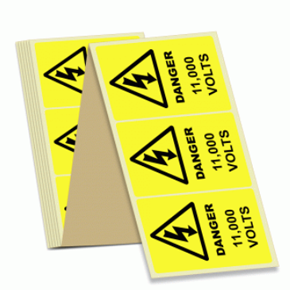
Preventing electric shocks in the construction industry
Electric shocks are one of the biggest causes of injury in the UK construction industry. However, injuries can be easily avoided be complying to the Electricity at Work Regulations Act 1989.
What do employers need to do?
The Health & Safety at Work Act 1974 states that employers are responsible for ensuring the health and safety of their employees and the public, if they are at risk from work activities.
To identify any hazards in place, it is important for employers to carry out thorough risk assessments. Once hazards have been identified, it is essential to have safety signs in place to warn employees.
In order to identify specific electrical details, Pat Labels Online supply a range of durable and reliable Pat Testing Labels.
What are the risks?
In order to understand the risks, the severity of an electrical hazard needs to be addressed. If preventions aren’t put in place, shocks, fires, explosions and burns can be caused.
An electric shock – usually an alternative current of frequencies of 50 Hz and 60 Hz passing through the body – can cause detrimental effects including internal burns, muscular contractions, brain injury, cardiac arrest and fibrillation of the heart.
Employers must remember that the safety of their employees is their responsibility, meaning that they are completely liable.
Latest news

17th April 2025
Nuaire shares expertise at Specifi Mechanical Services events in 2025
Indoor air quality and ventilation manufacturing specialist Nuaire is pleased to be exhibiting at the Specifi Mechanical Services events once again in 2025.
Posted in Air Conditioning, Articles, Building Industry Events, Building Industry News, Building Products & Structures, Building Services, Exhibitions and Conferences, Facility Management & Building Services, Heating, Ventilation and Air Conditioning - HVAC, Restoration & Refurbishment, Retrofit & Renovation
15th April 2025
West Fraser: CaberDek earns top marks from Home Counties carpentry specialist
A specialist carpentry sub-contractor covering housing sites across a large swathe of the Home Counties has come to value CaberDek from the West Fraser range for a variety of reasons: not least because the high quality panel product doesn’t destroy his operatives’ electric saws!
Posted in Articles, Building Industry News, Building Products & Structures, Building Systems, Case Studies, Restoration & Refurbishment, Retrofit & Renovation, Roofs, Timber Buildings and Timber Products, Wooden products
15th April 2025
GEZE: The Role of Access Control Systems in Enhancing Building Safety
Jane Elvins, Specification and Business Development Manager at GEZE UK, delves into the role of access control systems in enhancing building safety…
Posted in Access Control & Door Entry Systems, Architectural Ironmongery, Articles, Building Industry News, Building Products & Structures, Building Services, Doors, Facility Management & Building Services, Health & Safety, Restoration & Refurbishment, Retrofit & Renovation, Security and Fire Protection
11th April 2025
Don’t Do a Dave! It’s Time to Lock FIT Show 2025 in Your Calendar!
It’s that time again – FIT Show is back! You could be forgiven for thinking there won’t be much new to see when FIT Show returns to the NEC from 29 April – 1 May. Wrong!
Posted in Articles, Building Industry Events, Building Industry News, Building Products & Structures, Building Services, Continuing Professional Development (CPD's), Exhibitions and Conferences, Information Technology, Innovations & New Products, Restoration & Refurbishment, Retrofit & Renovation, Seminars, Training
 Sign up:
Sign up: